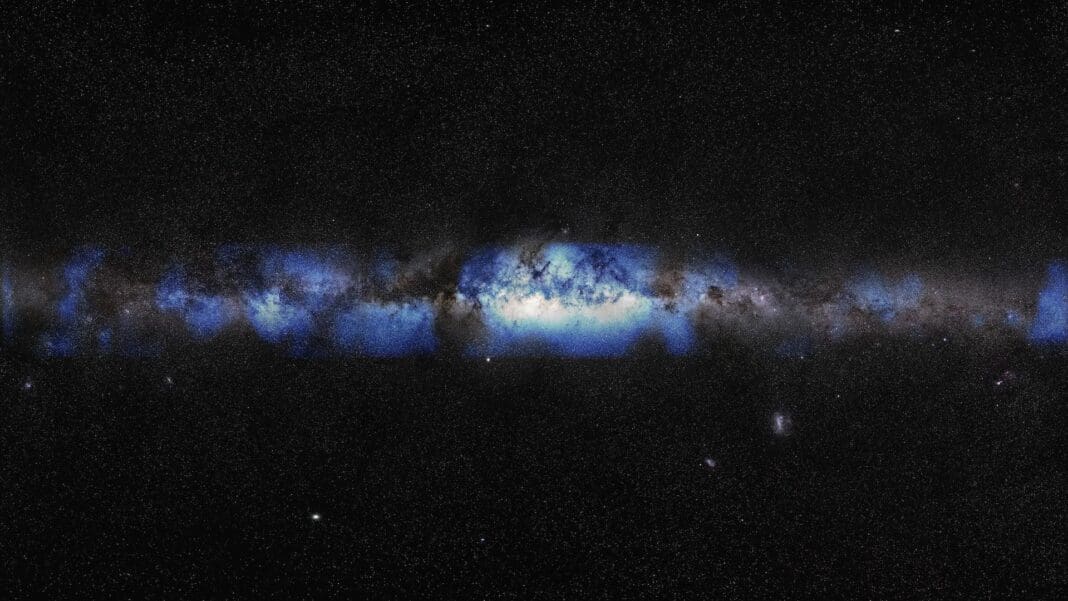The South Pole IceCube Neutrino Observatory – the biggest and strangest telescope in the world – has detected the first neutrino emissions from within the Milky Way, an achievement that will shape how astronomers view our galaxy.
Neutrinos are tiny, electrically neutral particles that pass through most matter undetected. They are created in extreme environments like those surrounding massive black holes, and they travel unhindered through space and matter in a straight path.
Because black holes and exploding stars are too far away to visit, and too extreme to reproduce in a laboratory, scientists rely on cosmic messengers – like visible light from stars – to study them. Neutrinos are another type of cosmic messenger, but they’re too small to be seen with our eyes, or even most types of telescopes.
That’s where IceCube comes in. The observatory, based in Antarctica, is made of up of a billion tons of ice equipped with a grid of frozen-in sensors. The sensors light up when they detect a neutrino passing through, and, based on the sensors’ arrangement, researchers can determine the energy and direction of the neutrino that created the flash.
From there, researchers can use the energy and direction to try to figure out where in the universe the neutrino came from.
As the interim director of the Wisconsin IceCube Particle Astrophysics Center, I ensure we have the people and resources needed to help researchers succeed in using the IceCube observatory.
Identifying the flashes of light from neutrino interactions on IceCube’s sensors can be a challenge. IceCube records about 2,600 events each second, though most of these events come from high-energy particles called cosmic rays, which also produce a steady rain of neutrinos upon hitting the Earth’s atmosphere. Only a few hundred of the hundred thousand neutrinos seen each year are from galactic or extragalactic sources rather than cosmic rays.
Finding the neutrinos from outer space, rather than those from cosmic rays, is like trying to see a faint feature in a portrait covered by many layers of paint – you have to be careful not to remove what you’re trying to uncover.
Surprisingly, the first two neutrino sources that IceCube researchers previously identified came from outside the Milky Way – one of which was a very bright galactic object called a blazar. These neutrinos were quite distant, but higher-energy than any sources from within the Milky Way.
Finding fainter Milky Way neutrinos required some clever work by IceCube collaborators at Drexel University and Dortmund University. Their work on IceCube’s detection of the first Milky Way neutrinos was published in Science on June 29, 2023.
Scientists can use a few tricks to filter neutrinos from outer space from cosmic ray neutrinos and other cosmic ray noise. We can sort by energy, with the higher-energy neutrinos being more likely to be from outer space. Researchers can also look for clusters of neutrinos, because neutrinos from outside our galaxy tend to clump together in one location. Lastly, researchers can look for neutrinos from transient, astrophysical events like black holes that have already been detected by other telescopes.
In 2013, IceCube published the first evidence of astrophysical neutrinos identified based on their energy. These were isolated single neutrinos – so researchers couldn’t tell exactly where they were coming from.
Even though scientists figured out that these most recently discovered neutrinos came from within our own galaxy, they don’t have a clear enough map of the Milky Way to identify the individual location where the newly uncovered neutrinos originated. Improving the analysis to determine the specific location of neutrino emission is the next step.
There are a few ways to improve the hunt for the sources. First, the longer scientists look and the more data they collect, the more likely they are to pinpoint a neutrino’s source – but to improve by a factor of 10 takes 100 times more data. So being clever has a better return than being patient.
Here are some ways to be more clever. First, researchers can improve the event selection by choosing which cosmic events to zero in on, so that more potential neutrino candidates are in the sample. They can also better reconstruct the neutrinos’ path – this is like revisiting a museum with new glasses to see with more clarity. Lastly, they can try to find a way to reduce the background, sort of like looking for a region where the portrait is covered by fewer layers of paint.
It took using all these tricks to see faint Milky Way neutrinos. Our team found ways to improve the sample size, and we used machine learning to improve the event reconstruction. This reduced the background enough to trace our neutrinos back to the Milky Way.
For most forms of cosmic light emission we study, light from sources within the Milky Way shine the brightest because they’re the closest. But for neutrinos, this isn’t the case – Galaxy NGC1068, tens of millions of light-years away, emits more high-energy neutrinos than the Milky Way. This tells us not all galaxies have the same ability to produce high-energy particles, but also that we need to to find and study more galaxies that emit neutrinos to understand the Milky Way’s cosmic quirks.
IceCube is planning a high-energy upgrade that would make the detector array about eight times larger. Once the upgrade finishes in the 2030s, scientists will be able to continue their search for neutrinos with improved technology.
This article is republished from The Conversation, an independent nonprofit news site dedicated to sharing ideas from academic experts. The Conversation has a variety of fascinating free newsletters.
Read more: The IceCube observatory detects neutrino and discovers a blazar as its source Scientist at work: searching for tiny neutrinos in the South Pole’s thick ice
Jim Madsen works for the University of Wisconsin-Madison where is the interim director of the Wisconsin IceCube Particle Astrophysics Center (WIPAC). He receives funding from National Science Foundation to support IceCube.













